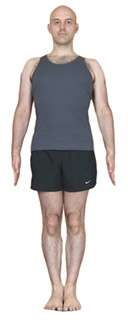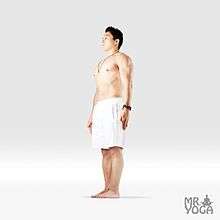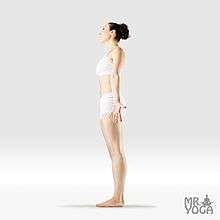Tadasana
 Man performing Tadasana from the front | |
| Etymology | |
|---|---|
| English Name(s) |
Tadasana Mountain Pose |
| Sanskrit |
ताडासन / Tāḍāsana समस्थितिः / Samasthitiḥ |
| Pronunciation |
[tɑːɖɑːsɐnɐ] [sɐmɐst̪ʰit̪ih] |
| Meaning |
tāḍa: "mountain" āsana: "posture" or sama: "even, balanced" sthiti: "stand, stop, stay" |
| Key Points | |
| dṛṣṭi (gaze) | नासाग्र दृष्टि / nāsāgra dṛṣṭi (to nose) |
| Asana Type | Standing Asanas |
| Difficulty Rating | Beginner[1] |
| Base Asana | Tāḍāsana is itself a fundamental āsana |
| Anatomy | |
| Muscles Stretched | -- |
| Ligaments Stretched | -- |
| Muscles Working | Intrinsic and extrinsic foot muscles, quadriceps, iliopsoas, piriformis, abdominal wall, and diaphragm |
| Joint Actions |
Mild Axial Extension: Lumbar, thoracic, cervical curves Neutral: Ankle, hip, shoulder, wrist joints Extended: Knee and elbow joints Pronated: Forearms Lifting Action: Arches of the feet, the pelvic floor, lower abdomen, rib cage, cervical spine, the top of the head Downward Grounding: scapulae, tailbone, points of contact in the feet |
| Usage | |
| Styles of Yoga | Yoga Krama, Ashtanga Yoga, Iyengar Yoga, Hatha Yoga |
| Location in Ashtanga Vinyasa Series | Sūrya Namaskāra and interspersed throughout all series |


Tadasana (IPA: [tɑːɖɑːsɐnɐ]; Sanskrit: ताडासन; IAST: Tāḍāsana) and Samasthiti (IPA: [sɐmɐst̪ʰit̪ih]; Sanskrit: समस्थिति; IAST: samasthitiḥ) are two names for a common standing yoga posture.[2] Tadasana is an asana. Depending on the Yoga lineage practiced, Samasthitiḥ and Tāḍāsana may refer to the same asana or two similar asanas.[3]
Etymology
Depending on the style of yoga, both Sanskrit names (Tāḍāsana and Samasthitiḥ) may refer to the same asana; one from the Sanskrit words tāḍa (Sanskrit: ताड meaning mountain) and āsana (Sanskrit: आसन [4] meaning "posture" or "seat"[5]), and the other from sama (Sanskrit: सम meaning "upright", "straight",[6] "equal", "level" [7] or "balanced" [8]), and sthiti (Sanskrit: स्थिति meaning "stand" or "stay" [9]).
Description
It is a basic standing asana[6] in most forms of yoga with feet together and hands at the sides of the body. There is some contention between different styles of yoga regarding the details of the asana which results in some variations.
PROCEDURE:-
Stand with feet together. Ground down evenly through feet and lift up through the crown of your head. Lift your thighs. Lengthen up through all four sides of your waist, elongating spine. Breathe easy. Although Tāḍāsana is a very basic asana, it is the basis and starting point for many standing asanas.[6]As such, Tāḍāsana is important in the context of other āsanas because it allows the body and consciousness to integrate the experience of the preceding āsana and prepare for the next. [10] Further, as a common and fundamental asana, Tāḍāsana can help develop habits for further practice and asanas.
Asanas that help prepare for Tāḍāsana include Adho Mukha Svanasana and Uttanasana. Urdhva Hastasana is a very similar asana with the hands raised above the head.
Drishti
The nāsāgra dṛṣṭi (Sanskrit: नासाग्र दृष्टि) at the tip of the nose is the correct dṛṣṭi for Tāḍāsana in the Ashtanga Vinyasa method. Sushumna dṛṣṭi is encouraged to draw the awareness inward. [8]
Bandhas
Uḍḍiyāna Bandha, Mūla Bandha and Jālandhara Bandha are all appropriate for Tāḍāsana.[11]
Variations
Due to terminological differences, Samasthitiḥ is sometimes considered a variation of Tāḍāsana.
- Placing the feet wider is common in vinyasa styles of yoga and provides a more stable base in this and other such standing asanas.[12]
- A variation called Prayer Pose involves the hands resting at the "heart's center" (in front of the sternum) in Namaste.[13]
- Further variations include turning the feet outwards so they point to the sides while keeping the heels together, with the hands together at the chest (in Anjali mudra), or palms pressed together behind the back in Paścime Namaskāra (Reverse Prayer Pose)[13] [14]
- Ūrdhva Vṛkṣāsana uses Tadasana as its foundation, but the gaze is upward to the Aṅguṣṭhamadhye dṛṣṭi (thumbs) and occurs twice in Surya Namaskara.[15]
There are also asanas which stem from Tāḍāsana but are not standing asanas, such as Supta Tāḍāsana (Reclined Mountain Pose) [16]
Iyengar yoga
In Iyengar yoga, when performing Tāḍāsana, the arms can be raised over the head or kept at the sides of the legs. In Iyengar yoga styles, Samasthitiḥ is synonymous with Tāḍāsana. [6]
Tāḍāsana appears in the 1st and 2nd weeks, of Iyengar's āsana courses (as detailed in Light on Yoga).[17]
Vinyasa Krama Yoga
In the Vinyasa Krama Yoga Tāḍāsana is performed on the toes, while samasthitiḥ is flat footed. In this style of yoga the two āsanas are different.[18]
In Vinyasa Krama Yoga, Samasthitiḥ is the centerpiece of the standing sequence and the foundation for the Hasta Vinyasas (arm vinyasas), Parsva Bhangi (side) vinyasas, Uttanasana (forward bending) vinyasas, and squatting/hip stretching asanas.[18]
In the Vinyasa Krama Yoga standing sequence, the final asana of the series (before śavāsana) is Tāḍāsana, performed on the toes.[18]
Ashtanga yoga
In Ashtanga Vinyasa Yoga, Tāḍāsana is the beginning and ending asana in the Sūrya Namaskāra sequence which is used to warm up the body and is sometimes interspersed throughout the entirety of all Ashtanga Series if performed with full vinayasas, in addition to being a foundational pose for all standing poses.[19]
Key aspects
Key aspects of Tāḍāsana are:
- Feet are together or if apart, then the heels and big toes are in one line pointing straight forward.[6][20]
- Feet are stretched on the floor, including metatarsals and each individual toe.[6]
- Feet "ground" primarily through the three points which make up the foot's three arches: the calcaneal tuberosity (heel), the base of the first metatarsal(big toe "knuckle"), and the base of the fifth metatarsal (little toe "knuckle"). [21] The weight is not placed on the inside edge of the feet (which would negatively affect posture throughout the body.)[22]
- Knees are tightened (in effect, the knee caps pulled up) and facing forward.[6][20]
- Keeping the balls of the feet grounded, and activating muscles to separate the soles of the feet (which are not allowed to move because of fricition with the mat), may help internally rotate the thighs, turn the femurs inward and keep the kneecaps facing forward. [23]
- Hips and buttocks (upper thigh muscles) are contracted (upwards). [6]
- Weight is distributed evenly between heels and toes, with the pelvis centred and body in-line.[6] The pelvis is centred when the tendons which connect the sartorius and rectus femoris muscles to the pelvis is halfway between being pulled tight, and relaxed. [24]
- Weight is distributed evenly between the two hips (equally between the two legs/feet), making the left and right hips level with each other.[24]
- Pelvis exhibits neutral tilt (neither tilted forward nor backwards). Usually this means the pubic symphysis and anterior superior iliac spine (ASIS) are in one vertical plane, neither in front of the other. [24]
- There is a moderate inward curve of the lower back due to the neutral pelvic tilt.[24]
- The chest is broad.[10]
- The shoulders are rolled back[10] (with the head of the humerus centred in the joint), and shoulder blades pulled down the back and inwards[10] (not "winging, but not "pinched" together).[25] The shoulders may be "looped" (lifted slightly, then brought back and down) to achieve this.[26]
- All bandhas, including Jalandhara Bandha are active.[11]
- The gaze is toward the nāsāgra dṛṣṭi (the tip of the nose). [8]
As with most yoga asana, when entering an asana, distal body parts are best arranged first, progressively adjusting inwards and putting proximal body parts in place last.[27]
Effects
The asana strengthens the abdomen and the legs. It may help relieve sciatica, reduce flat feet, and help plantar fasciitis and heel spurs by improving the strength of deeper foot muscles which support your foot, and reducing the load on the less suited plantar fascia. [21]
Cautions
- Due to the effects of standing, prolonged practice of Tadasana and its standing variations should be done with caution by those who suffer from headaches, insomnia, or low blood pressure.[12]
- It is advised to maintain a degree of muscle tension in this asana. Moderate tension in the thighs and hips can help develop positive habits and can increase the musculature in those areas which can help prevent injury. Additionally maintaining a degree of tension requires awareness, which can help prevent injury itself. Though in this asana it is unlikely to injure one's self, this habit can be beneficial throughout yoga practice.[28]
- Hyper extension of the knee can compresses the knee joint and can strain the medial meniscus, causing knee problems.[29]
- Since the feet serve as a foundation for the rest of the body in this and other standing asanas, the position of the feet is of high importance. Minor alteration in the position of the feet affects posture throughout the body. [30]
Anatomy
Parts of the body which play an important role in performing this asana are: both the intrinsic and extrinsic muscles of the feet, the quadriceps, the iliopsoas muscles, the piriformis, abdominal wall, and the diaphragm.[1]
The position of the body can be described anatomically as:
- The ankle, hip, shoulder, and wrist joints are neutral, halfway between flexion and extension, with the elbow joints extended and forearms pronated.[1]This means the feet are flat and parallel, and the hands are next to the thighs with the thumbs facing forward [30] (in a distal position).[31]
- The knees are straight, but not hyper-extended. Further, the kneecaps are lifted by the quadriceps femoris and the ischial tuberosites maintain tension via the hamstrings.[1] [30]
- The abductor muscles hold the thighs together. [30]
- The following points through the body are lifted upward: the arches of the feet, the pelvic floor, the lower abdomen, the rib cage, cervical spine, and the top of the head.[1] In this position, akin to standing "smartly", the action of standing erect should do most of the lifting without much special effort from the subject. [30]
- The curves of the lumbar, thoracic, and cervical exhibit mild axial extension.
- Downward release exists in the following parts of the body: the shoulder blades (supported by the rib cage), the tailbone, and in the foot at the heel (Calcaneus), and the first and fifth metatarsals (the three of which serve as primary contact points with the ground). The shoulders should not be thrown back, but simply relaxed neutrally.[30]
If the hands are raised over the head, palms together, (as per the variation) this stretches the thoracic cavity and rib structures including the intercostal muscles and expands the thoracic cavity increasing lung capacity. A slight back bend could be included to accentuate the effect and stretch the front of the body, chest and ribs more.[32][33]
See also
References
- 1 2 3 4 5 Kaminoff 2007, p. 35.
- ↑ "Yoga Journal - Mountain Pose". Retrieved 11 April 2011.
- ↑ Kaminoff 2007.
- ↑ Ranjini 2012, p. आसन entry.
- ↑ Sinha 1996, p. 18.
- 1 2 3 4 5 6 7 8 9 Iyengar 2005, p. 41.
- ↑ Ranjini 2012, p. समा entry.
- 1 2 3 Steiner 2012, p. Samasthitih.
- ↑ Ranjini 2012, p. स्थिति entry.
- 1 2 3 4 Fitz-Simon 2010, p. Standing Poses: Tadasana (Mountain Pose).
- 1 2 Ramaswami 2005, p. 2.
- 1 2 Kaminoff 2007, p. 39.
- 1 2 Ramaswami 2005, p. 3.
- ↑ Fitz-Simon 2010, p. Arm Variations - Pashima Namaskarasana.
- ↑ Steiner 2012, p. Urdhva Vrikshasana.
- ↑ Fitz-Simon 2010, p. Supta Tadasana.
- ↑ Iyengar 2005, p. 131 (Appendix: āsana courses).
- 1 2 3 Ramaswami 2005, p. 1-34.
- ↑ Maehle & 2011 880.
- 1 2 Cole 2004, p. 1.
- 1 2 Karminoff 2007, p. 36.
- ↑ Maehle 2011, 868-869.
- ↑ Long 2010, p. 33.
- 1 2 3 4 Cole 2004, p. 2.
- ↑ Guthrie 2012, p. "Check Your Alignment" Section.
- ↑ Maehle 2011, 814.
- ↑ Coulter 2001, p. 229, 233, 236, 370, 543.
- ↑ Coulter 2001, p. 229.
- ↑ Mccall 2007, 9055-9056.
- 1 2 3 4 5 6 Coulter 2001, p. 230.
- ↑ Long 2010, p. 09.
- ↑ Kaminoff 2007, p. 25-26.
- ↑ Coulter 2001, p. 102.
Sources
- Iyengar, B. K. S. (1 October 2005). Illustrated Light on Yoga. HarperCollins. ISBN 978-81-7223-606-9.
- Budilovsky, Joan; Adamson, Eve (2000). The complete idiot's guide to yoga (2 ed.). Penguin. ISBN 978-0-02-863970-3.
- Sinha, S.C. (1996). Dictionary of Philosophy. Anmol Publications PVT. LTD. ISBN 978-81-7041-293-9.
- Coulter, H. David (2001). Anatomy of Hatha Yoga. Body and Breath Inc. ISBN 978-0-9707006-0-5.
- Kaminoff, Leslie (2007). Yoga Anatomy. The Breath Trust. ISBN 978-0-7360-6278-7.
- Long, Ray; Macivor, Chris (2009). Scientific Keys: The Key Muscles of Yoga Volume 1. Bandha Yoga. ISBN 978-1-60743-238-8.
- Ramaswami, Srivatsa (2005). The Complete Book of Vinyasa Yoga. Da Capo Press. ISBN 978-1-56924-402-9.
- Cole, Roger (2004). "Intuitive Alignment: Tadasana Hips". Selected Article Resources on Yoga Injuries. Retrieved 12 May 2012.
- Maehle, Gregor (2011). Ashtanga Yoga Practice and Philosophy. Kindle Edition. New World Library.
- Steiner, Dr. med. Ronald P. (2012). "AshatangaYoga.info". Retrieved 12 May 2012.
- Ranjini, V.V.; Paranjape, Kiran; Ramapriyan, H. K.; Gaurav; Las; Glashoff, K.; Mohan, Sam; Gallo, A. (2012). "SpokenSanskrit Dictionary". Retrieved 11 March 2012.
- Fitz-Simon, Witold (2010). "Yoga Art and Science". Retrieved 4 February 2012.
- Guthrie, Catherine (2012). "Wear and Care". Retrieved 2012. Check date values in:
|accessdate=(help) - Long, Ray (2010). Yoga Mat Companion 1: Anatomy for Vinyasa Flow and Standing Poses. BandhaYoga. ISBN 978-1-60743-943-1.
Further reading
- Saraswati, Swami Satyananda (1 August 2003). Asana Pranayama Mudra Bandha. Nesma Books India. ISBN 978-8-18633-614-4. Retrieved 9 April 2011.
- Saraswati, Swami Satyananda (January 2004). A Systematic Course in the Ancient Tantric Techniques of Yoga and Kriya. Nesma Books India. ISBN 978-8-18578-708-4. Retrieved 9 April 2011.
- Dollar, Cindy; Susanna MacKenzyie Euston (2004). Yoga your way: customizing your home practice. Lark Books. ISBN 978-1-57990-573-6.
- Bikram, Choudhury (2007). Bikram Yoga. HarperCollinsPublishers. ISBN 0-06-056808-9.